“It is well to be up before daybreak, for such habits contribute to health, wealth, and wisdom.”
– Aristotle
Introduction
For the last two months I have been a full-time polyphasic sleeper. It’s been one of the best lifestyle decisions I’ve made in my life.
My energy levels during my waking hours have never been higher. I’m waking up hours earlier than I used to – and getting way more done. My alertness and focus has peaked. It almost feels like a superpower.
Just to give you an idea… following a polyphasic schedule, I completed all of my monthly goals for November in just ten days.
 I’ve done four product launches, one crowdfunding campaign, had guest interviews on over 10 podcasts, completed five guest blog posts, hosted a live two-hour webinar, finished two client campaigns, and closed two important deals.
I’ve done four product launches, one crowdfunding campaign, had guest interviews on over 10 podcasts, completed five guest blog posts, hosted a live two-hour webinar, finished two client campaigns, and closed two important deals.
Polyphasic sleep is, to me, the ultimate life hack.
The question is: would you like to possess this power for yourself?
How to navigate this article – Click on any link to jump to a specific section:
What Polyphasic Sleep is – and Isn’t
The Slingshot Effect
Bi-phasic Siesta
Everyman Two and Three
Getting Started With Polyphasic Sleep
Keys to Making this Work
How to Structure Your Ideal Day
Mitigation and Control Factors
Downsides of Polyphasic Sleep
Misconceptions and FAQs
Also – if you love this post, then you’ll love my “Sleep Hacking Masterclass” on Udemy. Just click this link and you can get a 97% discount on the other course.
What polyphasic sleep is – and what it isn’t
Polyphasic sleep is the practice of breaking up sleeping patterns into much less sleep at night, and replacing the lost sleeping hours with daytime napping.
On the surface, it would seem that polyphasic sleep would only be a peculiarity unique to the wired young Silicon Valley entrepreneur (ala Mark Zuckerberg) type, trying to squeeze more hours of productivity into his day… and other outliers on the fringes.
In reality, most people who engage in polyphasic sleep do so as a cure to get back lost hours of sleep; and for this, it’s very effective.
There are times when life just gets too busy; we always have to be on the go and have to maintain peak energy. We only get a bare minimum number of hours of sleep per night, but need to keep going and doing more the next day.
Enter polyphasic sleep, one of the most effective ways to cure sleep deprivation, gain extra hours of the day, and have more energy than ever.
Some of the best known polyphasic schedules are:
1. Bi-phasic siesta – daily nap after lunch
2. Traditional bi-phasic – four hours core sleep, two hours awake, four hours core sleep
3. Everyman 2, 3, and 4 – two, three, or four daily naps, spaced between 4 – 6.5 hours apart
4. Tri-phasic – three 90 minute naps, no core sleep
5. Dymaxion – four half-hour naps, no core sleep
6. Uberman – six twenty minute naps, no core sleep
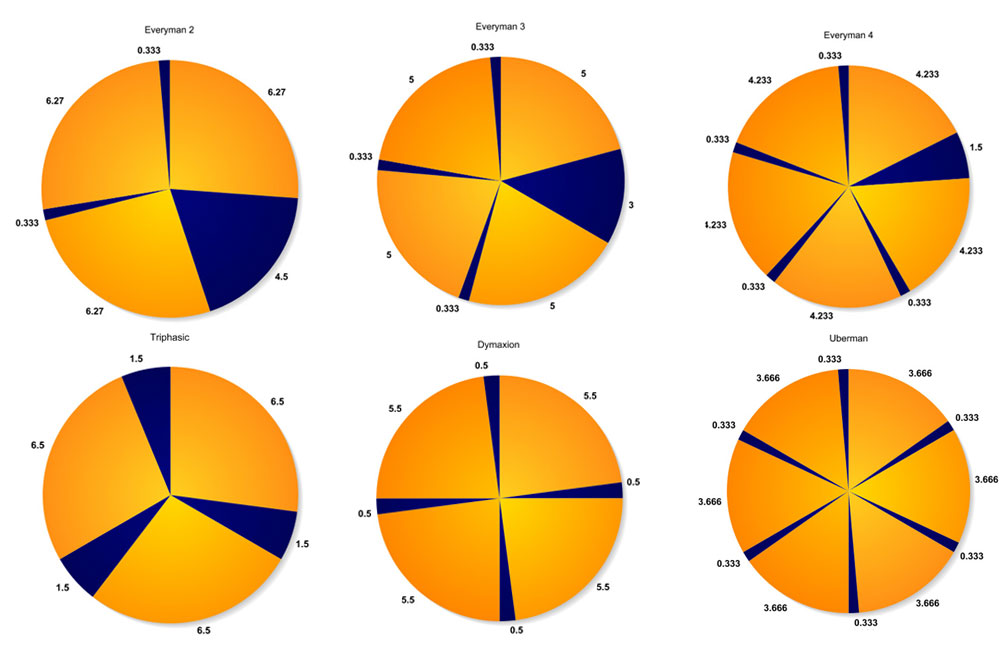
(The yellow area represents waking time, sleep periods are in dark blue)
Feeling a bit overwhelmed? It’s ok, I did too.
The problem: some of these cycles are based on hearsay, or accounts of historical figures. For example, one person is only ever supposedly reported to have followed the Dymaxion sleep schedule: Buckminster Fuller. There’s no conclusive evidence that it is even possible, or that Fuller stuck to this schedule to the letter (all we have is his word). He may have sensationalized his sleep patterns to boost his reputation.
The real question is: which cycles are actually practical and doable for the average person? Let’s start there.
Bi-phasic Siesta and Everyman Two.
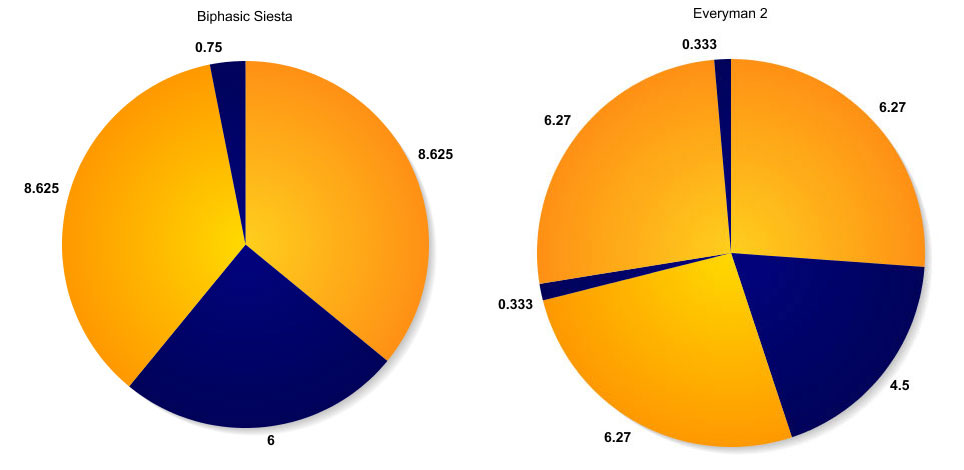
If you’re new to polyphasic sleep, I recommend that you focus exclusively on these two schedules.
The Slingshot Effect
Sneaking in a quick 30-minute nap when your circadian rhythm dips to its lowest (at 3:00pm or a bit before or after) is very doable even for people with a regular job. The siesta method alone is a vast improvement over a monophasic schedule, because if you miss a nap at 3:00pm you miss the chance to maximize the next peak in your circadian rhythm at around 6:00pm.
When you skip taking a nap when your cycle is at its lowest, aligned to its natural ebb and flow, you go on burning energy throughout the day. The only way is down and towards the end of the day you are exhausted.
But taking advantage of a period of rest allows you to “rebound” and it can create massive implications for your health, energy, mental prowess, and productivity. This is called the slingshot effect:
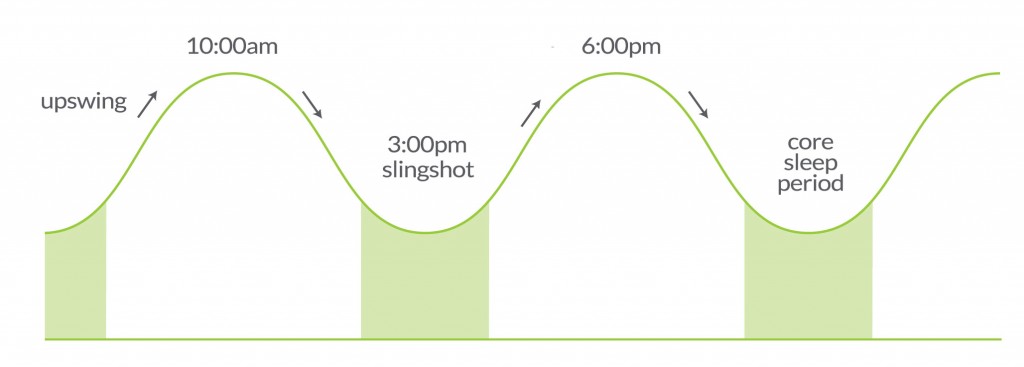
We’re going to talk more about how to take advantage of the slingshot effect and use it to transition into polyphasic sleep, using bi-phasic to start and then transitioning to the Everyman sleep schedule.
Bi-phasic Siesta: 6 Hours Core Sleep, One Mid-Afternoon Nap
Speaking from my own experience, I have mainly followed a “bi-phasic siesta” sleep pattern for the last several years. This far and away the most practical strategy for most people. See the napping strategies in my Udemy course for more help with this.
Anecdotal evidence suggests that one 20 minute nap (I shoot for 30) can reduce two hours from your daily sleep requirement, and my own experience confirms this to be true. Furthermore, the mid-afternoon nap at or near 3:00pm seems to be the most powerful, even if you move to a twice or thrice daily napping schedule.
The siesta method also provides the nudge to break away from a monophasic schedule and the training wheels to become a skilled napper. Once you’ve incorporated this routine and practice napping at least 3 or 4 times per week, then you’re ready to graduate to the next stage: Everyman Two.
Everyman Two and Three: 4-5 Hours Core Sleep, Two or Three Daily Naps
The Everyman Two is also an extremely practical schedule to follow. I sort of “chanced” into this cycle by accident when my work and social life became extremely busy.
If you’re self-employed without a boss and have the luxury to snooze whenever you wish, you can get great results simply from following the “Everyman 2” routine.
First, to make this work you really have to be strict about arranging your work and your daily schedule to keep the mid afternoon (around nap-time) sacred. Following the Everyman Two, it is possible to vary the timing of the second nap.
What I found works best for me was:
- One core sleep period (starting between 11:00pm and midnight, finishing between 4:00am – 5:00am)
- Staple nap at 3:00pm (though sometimes 2:30pm, 3:30pm, etc.)
Here’s where things got interesting:
- The second nap I would either take at around 7:30pm or 8:00pm (before going out), or at around 11:30am. That means the timing was optional, based on how I felt, how well I slept the previous night, and whether I was planning to go out that night.
- Sometimes I would slip into Everyman 3, and take both naps.
- The “sweet spot” for the additional naps was to time them so that my additional nap was either approximately four hours before my afternoon siesta (3:00pm), or four/five hours afterwards.
In my experience, your sleep schedule on the Everyman is flexible, able to fluctuate based on how busy you are and what you’ve got going on. If your day is packed, or if you’re going out late and waking up early, having an extra nap in your arsenal can be a secret weapon.
I’ve noticed is that it’s very easy to transition from bi-phasic siesta to Everyman 2, then to Everyman 3, and back again. That means you don’t really have to force yourself into a static routine. For me, I simply do what feels natural to my body: rest when I’m at my lowest, and perform in “sprints” of high energy when I’m at my peak.
![]()
Getting Started with Polyphasic Sleep
- Train yourself to nap. Learn good fundamentals of sleep hygiene: light exposure, how to naturally stimulate melatonin and adenosine production, meditation, anchoring and so on
- Start performing sleep restriction. Reduce the hours you spend in bed. You’ll have to experiment with this and find a strategy for sleep minimalism that works for you. This can happen naturally if you’re really busy – going out a lot, entertaining guests, taking late night international calls, etc.
- Set an early wake up time and once you’re awake, get yourself up immediately.
- Set time for a second nap either four hours before your siesta or four hours afterward.
- If you’re really busy or extra sleep deprived, you can transition to Everyman 3 and take both of the additional naps. This might only be temporary (it was for me.)
By restricting the amount of your core sleep, you train yourself to fall asleep extremely fast. Test one fewer hour in bed to start, and work your way up to two (one hour later bedtime, one hour earlier wake up time). Eventually you can get to 5 hours, and then down to four and a half (ideal).
![]()
Keys to Making this Work
To really give polyphasic sleep a run for its money, you have to have the right things to fill up your waking hours. You have to be busy… preferably doing epic shit.
This way, you’re not just using those extra hours to waste time playing video games or watching uTorrented movies. It simply cannot work this way.
If you reach in your life where you have a lot of important work to complete and a variety of commitments on your time, THEN a polyphasic schedule can work – in fact, it becomes very practical.
Polyphasic sleep is a band aid for people who are already uber-busy.

Look to the examples of classical polyphasic sleepers that we know of: Thomas Edison. Oscar Wilde. Buckminster Fuller.
Beavis and Butthead, Homer Simpson, and lazy people in general don’t make the list.
Polyphasic sleep schedules (such as the Everyman) work best for writers, entrepreneurs, anyone who engages in creative work (and you’ll understand why once I talk about how I organize my to-do list and structure my day).
Writers, by far, are the best suited for polyphasic sleep because there is always more to write. Writers always have ideas flowing through our heads that we need to give form to. And there is always more work that needs to be done: books that need to be written, blog posts, guest columns, newsletters, scripts (for courses such as this one), and so on. I constantly pull out my laptop to sneak in extra minutes to write when I’m having lunch, or if I’m commuting by bus or train.
To make this work, you have to be able to organize and structure your waking hours and use the polyphasic schedule to squeeze maximum output from those hours (I also find that a looming nap is an effective deadline to keep me focused as I work).
You also have to be keenly aware of energy fluctuations in your circadian rhythm; I often grade my energy levels into three categories (more on that later).
Adenosine (one of the hormones that makes you sleepy) production corresponds to the activity levels of the brain’s neurons. When you’re busy forming visual images in your mind, recalling memories, and solving problems, adenosine production increases (and you sleep better).
Also, I find that you have to keep your social life low-maintenance. That means, if you have a date, have them come over to your place so that you can cook for them instead of going to their place to meet them. That way you can sneak a nap in before they arrive.
You need to keep your bed near so that napping becomes efficient and so that you maximize waking hours. Avoid long commutes as much as possible while on a polyphasic schedule.
![]()
How to Structure Your Ideal Day
First of all, since we understand that under our circadian rhythms our energy levels are continually fluctuating, it’s important to divide up our waking activities to match our levels of energy.
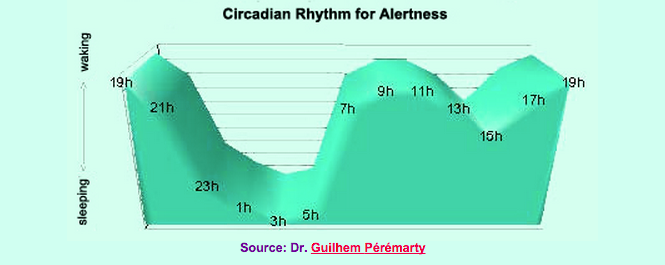
The solution that I’ve arrived at is to divide my work (and to-do list) into three categories carefully aligned to peaks and troughs in my circadian rhythm:
1) Level one work (intense focus): these are activities when you need to be at your best; creative work to do when your circadian rhythm is at its peak. Reserve this work for when your body temperature is at its highest during the day.
Other activities that require you to be at your best are ideal level one activities: public speaking, writing pitches, creating videos (such as this one), important meetings. The key is to schedule these into your day to align with peaks in your circadian rhythm.
2) Level two work (moderate focus): Replying to messages and e-mail, editing content, preparing content (such as finding images to add to a blog post). Level two activities require a moderate amount of attention and thought; but these are less intensive tasks which don’t require a maximum amount of focus and concentration.
3) Level three work (rote activity): Level three activities consume very little mental energy. These are rote tasks that are redundant, usually copy and paste. For example, each time I do a book promotion I need to submit my book’s information to a number of e-book newsletter sites. This involves little more than filling in forms, with the same standard set of questions: Name of the book, author name, description, and so on.
Other level three tasks might involve replying to comments on social media, posting photos to your Facebook or Instagram, or just anything mundane that requires little more beyond standard clicking of a mouse.
Throughout my day, I’ll “grade” myself to assess which zone I am in. If I’m in level one, I keep that time sacred and block out interruptions to “swallow the frog” – get my most important work done. When my energy starts to fall, I’ll stop my level one work and transition to level two. When my circadian rhythm drops (such as during the recovery time following a nap), I can get my level three tasks done.
The point is that you really need to get good at keeping a strict schedule to take advantage of the peaks in your rhythm, as well as use the extra time awake productively, and time the naps at the right points.
![]()
Mitigation and Control Factors
Practicing good sleep hygiene and being disciplined is very important.
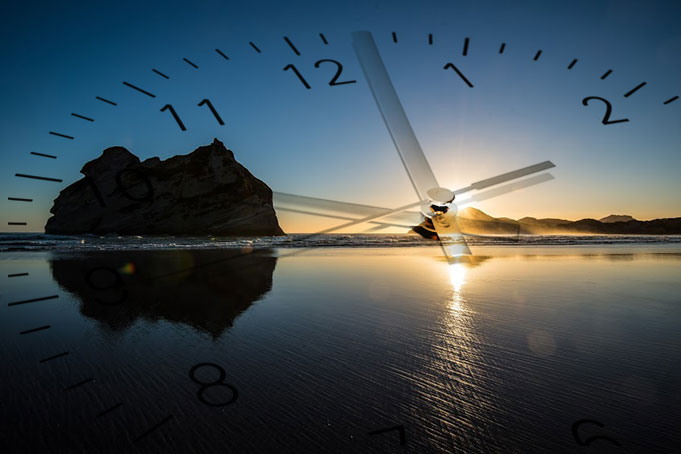
Four hours of sleep at night is ONLY practical if you’re able to get a high concentration of light exposure immediately upon waking and throughout the day.
If you are not getting enough light during the day, your energy levels will not stay high and you will be too tired to make this work. I have three ideal times during my day where I try to get direct sunlight exposure:
- Immediately upon waking, to get myself up and start by body clock.
- Sometime around noon, when the sun provides the most light (100,000 – 120,000 Lux)
- After my afternoon siesta (to get myself up again)

Coconut oil is another secret weapon to make polyphasic sleep work.
Evidence suggests that coconut one or two teaspoons of coconut oil each day can increase your body temperature by 1 degree Fahreinheit.
Even just a moderate increase of one degree in body temperature can dramatically improve your levels of energy, alertness, and mood during the daytime.
Avoid Unknown Variables
To make your polyphasic schedule easier, be wary of adding in any unknown factors. In other words, keep your diet and exercise fairly consistent.
I messed myself up big time when, one afternoon after a Thai massage, I was offered a complimentary cup of tea. I knew better, but figured I could handle half a cup. I couldn’t. I lied in bed half-awake the entire night and all but ruined my next day.
The lesson? I am a coffee drinker – a morning cup of coffee is a consistent part of my routine, and my body has is accustomed to it. I hadn’t drunk tea in a long time, and the tea’s theophylline had a far longer shelf life in my bloodstream than the caffeine from coffee because my body wasn’t used to it. It didn’t know how to filter it out.
The lesson is to keep things consistent. Don’t introduce any foreign variables which could potentially throw off your rhythm. Even intangibles, such as stress from work, can throw off this cycle. These sometimes cannot be avoided but can be mitigated through healthy practices such as maintaining a gratitude journal, quiet meditation, and breathing exercises.
![]()
Downsides of Polyphasic Sleep
There were two main downsides that I’ve experienced from polyphasic sleep, based on my experience. The first is an increase in muscle fatigue. The second is less time spent in REM sleep (which makes us less likely to experience dreams).
While polyphasic sleep is a great way to keep the mind refreshed and feeling light, it’s not quite the same with the body. Less hours in bed means more strain on your system. If you work on a laptop, you’ll experience more strain on your back, shoulders, and neck while on a polyphasic schedule.
I was able to mitigate this to a large extent through two measures: working from a standup desk (to prevent strain) and massage (to reverse it). First, if you work on a computer, make sure to work from a standup desk every single day. The less time you spend in a chair the better.
Next, I highly recommend getting at least one massage per week, though two or three is even better, as it will also make it easier to fall asleep.
Regarding REM sleep, you may recall from earlier sections of this course that REM is concentrated in the latter cycles of sleep before waking. When you shorten your main chunk of sleep at night from 7.5 hours down to 4.5 you go through three cycles instead of five.
Deep non-REM sleep is concentrated in the first three Ultradian cycles: all of us get around 100 minutes total each day, and it matters not whether we sleep for four hours or for ten.
Furthermore, more hours spent awake equals a greater concentration of adenosine, which increases non-REM sleep, but not REM sleep. Therefore the trade off is that through a polyphasic sleep schedule, you get a greater concentration of the deep non-REM sleep which is vital to your waking life; however, you get less REM sleep, which is not vital but important for certain brain functions such as memory recall.
The third potential downside of polyphasic sleep is that it’s difficult to perform bodybuilding while on a polyphasic schedule. When you engage in strenuous physical activity that tears down muscle tissue, it requires extra hours of sleep to rebuild the tissue.
The best exercise to engage in while going polyphasic is light, high-intensity workout that minimizes fatigue and tissue breakdown.
![]()
Misconceptions and FAQs
Sadly, there’s a lot of misconceptions floating around about polyphasic sleep, and just about sleep in general. Most of the information we have about polyphasic sleep comes from blogs, where writers sometimes make sweeping statements which aren’t grounded in scientific backing. When this faulty or misleading information is accepted as truth, it becomes dangerous.
Steve Pavlina’s blog is one of the most cited sources with regards to polyphasic sleep, particularly this article.
Unfortunately, the premise of Mr Pavlina’s post is fundamentally wrong, especially these two points:
- “REM is the most important phase of sleep”This assertion, often cited, is not true. REM is not the most important phase of sleep, nor is it vital for survival. Deep non-REM sleep is the phase that the brain prioritizes, and it is the only phase of sleep necessary for organic survival, as scientific evidence, such as cited in this article, has clearly pointed out.Several decades ago, William Dement deliberately restricted test subjects from getting any REM sleep for a matter of weeks. No harmful side effects were recorded. Since sleep is absolutely necessary for survival, but we can make do without any REM, then the conclusion is that non-REM sleep must be the most important phase of sleep.
- “Polyphasic sleep conditions your body to learn to enter REM sleep immediately when you begin sleeping instead of much later in the sleep cycle.”Another misplaced assumption based on a faulty premise. Since we know REM sleep is not vital, this point doesn’t have any footing to start with. And REM sleep occurs in all cycles, not just the latter ones. Furthermore, the body is not responsible for REM sleep – or any sleep for that matter. Sleep is controlled through the brain.
Other misconceptions / FAQs:
- “Polyphasic sleep sounds interesting, but can’t it be risky to your health?”First of all, there’s no hard evidence that we have that polyphasic sleep has any really risks whatsoever. Writers make misconceptions and then write articles about misconceptions, and then the information is spread and accepted as fact.In this case many people are missing the point. Most polyphasic sleepers use a polyphasic schedule as a cure for sleep deprivation rather than as some neat idea to sleep less. For recouping lost sleep, its very effective. As mentioned in the section above, the only downsides I’ve experienced are increased muscle fatigue and less time in REM sleep.
- “I don’t have time to nap”That’s precisely why you need to start becoming a bi-phasic, or polyphasic sleeper, immediately! With each nap you take, you’re gaining back so much more. You get back extra hours in your day, and you increase your energy and focus for when you need it most.
![]()
That’s about it! Enjoy your new superpowers.
Use them wisely.
This covers everything I’ve learned from my experiment with polyphasic sleep. A lot of the information here was thoroughly researched during the process of writing my best-selling book “Hack Sleep” and creating my online course, “The Sleep Hacking Masterclass.”
If you’re interested in learning more about the topic, I highly recommend checking those two products out!
Also – have any questions? Comments? Want to show your love? Leave me a comment and I will reply.





